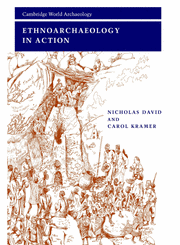Book contents
- Frontmatter
- Dedication
- Contents
- List of figures and credits
- List of tables
- Preface
- Acknowledgments
- Map
- 1 Ethnoarchaeology: its nature, origins, and history
- 2 Theorizing ethnoarchaeology and analogy
- 3 Fieldwork and ethics
- 4 Human residues: entering the archaeological context
- 5 Fauna and subsistence
- 6 Studying artifacts: functions, operating sequences, taxonomy
- 7 Style and the marking of boundaries: contrasting regional studies
- 8 Settlement: systems and patterns
- 9 Site structures and activities
- 10 Architecture
- 11 Specialist craft production and apprenticeship
- 12 Trade and exchange
- 13 Mortuary practices, status, ideology, and systems of thought
- 14 Conclusions: ethnoarchaeology in context
- Bibliography
- Index
Preface
Published online by Cambridge University Press: 05 March 2015
- Frontmatter
- Dedication
- Contents
- List of figures and credits
- List of tables
- Preface
- Acknowledgments
- Map
- 1 Ethnoarchaeology: its nature, origins, and history
- 2 Theorizing ethnoarchaeology and analogy
- 3 Fieldwork and ethics
- 4 Human residues: entering the archaeological context
- 5 Fauna and subsistence
- 6 Studying artifacts: functions, operating sequences, taxonomy
- 7 Style and the marking of boundaries: contrasting regional studies
- 8 Settlement: systems and patterns
- 9 Site structures and activities
- 10 Architecture
- 11 Specialist craft production and apprenticeship
- 12 Trade and exchange
- 13 Mortuary practices, status, ideology, and systems of thought
- 14 Conclusions: ethnoarchaeology in context
- Bibliography
- Index
Summary
When in early 1997 we decided to start writing the book about ethnoarchaeology that we had talked about for years, we both naïvely thought that this could be achieved by little more than putting our course notes together and filling in some blanks. Our experience has been very different. We never intended to write a text for beginning students but rather a stocktaking of a subdiscipline of anthropology some 45 years after its inception, and to do this we have had to think through our understandings of the topic, and to expand them by much further reading. In this we were greatly assisted by the Bibliography of ethnoarchaeology and related studies (David et al. 1999) that Nicholas David (hence-forth, except in references, ND) had been compiling and developing for several years. However, the magnitude of the task and the inevitability of our failure to do a thorough job is apparent in its accumulation, as of the day this is written, of 883 items classified primarily as ethnoarchaeology. We wished not to produce a catalogue, a collation, or an encyclopedia, but rather, via a critical reading of case studies, to guide the reader towards an informed understanding of theoretical, methodological, and substantive issues in ethnoarchaeology at the turn of the millennium. Decisions had to be made.
The first was to adopt a restrictive definition of ethnoarchaeology, one that requires the involvement of ethnographic fieldwork in elucidation of relationships between material culture and culture as a whole.
- Type
- Chapter
- Information
- Ethnoarchaeology in Action , pp. xxi - xxiiPublisher: Cambridge University PressPrint publication year: 2001

